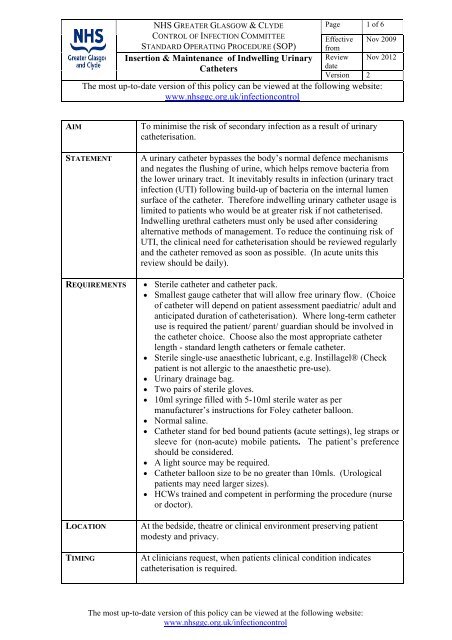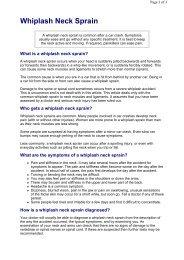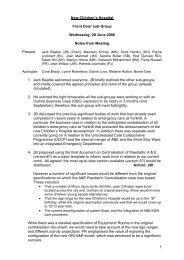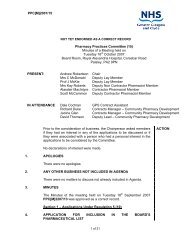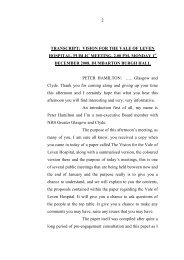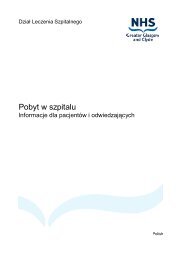Insertion & Maintenance of Indwelling Urinary Catheters The most ...
Insertion & Maintenance of Indwelling Urinary Catheters The most ...
Insertion & Maintenance of Indwelling Urinary Catheters The most ...
You also want an ePaper? Increase the reach of your titles
YUMPU automatically turns print PDFs into web optimized ePapers that Google loves.
AIM<br />
NHS GREATER GLASGOW & CLYDE<br />
Page 1 <strong>of</strong> 6<br />
CONTROL OF INFECTION COMMITTEE<br />
STANDARD OPERATING PROCEDURE (SOP)<br />
Effective<br />
from<br />
Nov 2009<br />
<strong>Insertion</strong> & <strong>Maintenance</strong> <strong>of</strong> <strong>Indwelling</strong> <strong>Urinary</strong> Review Nov 2012<br />
<strong>Catheters</strong><br />
date<br />
Version 2<br />
<strong>The</strong> <strong>most</strong> up-to-date version <strong>of</strong> this policy can be viewed at the following website:<br />
www.nhsggc.org.uk/infectioncontrol<br />
STATEMENT<br />
REQUIREMENTS<br />
To minimise the risk <strong>of</strong> secondary infection as a result <strong>of</strong> urinary<br />
catheterisation.<br />
A urinary catheter bypasses the body’s normal defence mechanisms<br />
and negates the flushing <strong>of</strong> urine, which helps remove bacteria from<br />
the lower urinary tract. It inevitably results in infection (urinary tract<br />
infection (UTI) following build-up <strong>of</strong> bacteria on the internal lumen<br />
surface <strong>of</strong> the catheter. <strong>The</strong>refore indwelling urinary catheter usage is<br />
limited to patients who would be at greater risk if not catheterised.<br />
<strong>Indwelling</strong> urethral catheters must only be used after considering<br />
alternative methods <strong>of</strong> management. To reduce the continuing risk <strong>of</strong><br />
UTI, the clinical need for catheterisation should be reviewed regularly<br />
and the catheter removed as soon as possible. (In acute units this<br />
review should be daily).<br />
• Sterile catheter and catheter pack.<br />
• Smallest gauge catheter that will allow free urinary flow. (Choice<br />
<strong>of</strong> catheter will depend on patient assessment paediatric/ adult and<br />
anticipated duration <strong>of</strong> catheterisation). Where long-term catheter<br />
use is required the patient/ parent/ guardian should be involved in<br />
the catheter choice. Choose also the <strong>most</strong> appropriate catheter<br />
length - standard length catheters or female catheter.<br />
• Sterile single-use anaesthetic lubricant, e.g. Instillagel® (Check<br />
patient is not allergic to the anaesthetic pre-use).<br />
• <strong>Urinary</strong> drainage bag.<br />
• Two pairs <strong>of</strong> sterile gloves.<br />
• 10ml syringe filled with 5-10ml sterile water as per<br />
manufacturer’s instructions for Foley catheter balloon.<br />
• Normal saline.<br />
• Catheter stand for bed bound patients (acute settings), leg straps or<br />
sleeve for (non-acute) mobile patients. <strong>The</strong> patient’s preference<br />
should be considered.<br />
• A light source may be required.<br />
• Catheter balloon size to be no greater than 10mls. (Urological<br />
patients may need larger sizes).<br />
• HCWs trained and competent in performing the procedure (nurse<br />
or doctor).<br />
LOCATION At the bedside, theatre or clinical environment preserving patient<br />
modesty and privacy.<br />
TIMING At clinicians request, when patients clinical condition indicates<br />
catheterisation is required.<br />
<strong>The</strong> <strong>most</strong> up-to-date version <strong>of</strong> this policy can be viewed at the following website:<br />
www.nhsggc.org.uk/infectioncontrol
NHS GREATER GLASGOW & CLYDE<br />
Page 2 <strong>of</strong> 6<br />
CONTROL OF INFECTION COMMITTEE<br />
STANDARD OPERATING PROCEDURE (SOP)<br />
Effective<br />
from<br />
Nov 2009<br />
<strong>Insertion</strong> & <strong>Maintenance</strong> <strong>of</strong> <strong>Indwelling</strong> <strong>Urinary</strong> Review Nov 2012<br />
<strong>Catheters</strong><br />
date<br />
Version 2<br />
<strong>The</strong> <strong>most</strong> up-to-date version <strong>of</strong> this policy can be viewed at the following website:<br />
www.nhsggc.org.uk/infectioncontrol<br />
PROCEDURE<br />
Explain the procedure and the rationale for the catheterisation to the<br />
patient/ parent/ guardian.<br />
• Wash hands with liquid soap and water then alcohol gel.<br />
• Put on a plastic apron.<br />
• Prepare a trolley or appropriate surface area with the required<br />
equipment and take it to the patient’s bedside.<br />
• Explain the procedure and ensure privacy.<br />
• Prepare the patient. Ensure the patient is not unduly exposed.<br />
• Place protective sheeting below the patient’s buttocks.<br />
• Decontaminate hands with alcohol hand rub.<br />
• Open the packs.<br />
• Decontaminate hands with alcohol hand rub.<br />
• Don sterile gloves (both pairs).<br />
Female Patients: Thoroughly cleanse the vulval area with either<br />
sterile saline/ sterile water or tap water swabbing from above<br />
downwards. Cleanse the labia minora vestibule in turn. Identify<br />
the urethral meatus and cleanse.<br />
Male Patients: Cleanse the glans penis with either sterile saline<br />
/sterile water or tap water. In non-circumcised patients, retract<br />
the prepuce (foreskin) slightly to enable the glans penis to be<br />
cleansed and the urethral opening to be visible. NB Do not fully<br />
retract a phimotic foreskin. Remember to return the foreskin to its<br />
normal position once the procedure is completed.<br />
Male and Female Patients:<br />
• Arrange sterile drape beneath the patient.<br />
• Inform the patient that the local anaesthetic is cold and may sting.<br />
• Apply sterile single-use anaesthetic gel. If using anaesthetic gel<br />
anaesthetise urethra by applying for adults, 6mls female or 11mls<br />
male <strong>of</strong> local anaesthetic slowly and evenly into the urethra.<br />
• Allow a minimum <strong>of</strong> 5 minutes to elapse before passing the<br />
catheter.<br />
• Discard first pair <strong>of</strong> gloves.<br />
• Position sterile bowl to catch urine.<br />
• Open inner cover <strong>of</strong> the catheter.<br />
• Lubricate the tip <strong>of</strong> the catheter using a swab covered in<br />
anaesthetic gel.<br />
• Gently insert the catheter and monitor flow <strong>of</strong> urine.<br />
• (Female patients: Do not touch any part <strong>of</strong> the vulva with the<br />
catheter).<br />
• (Male patients: ensure that the glans penis is held at an angle<br />
away from the abdomen during catheterisation to allow the<br />
smooth passage <strong>of</strong> the catheter).<br />
<strong>The</strong> <strong>most</strong> up-to-date version <strong>of</strong> this policy can be viewed at the following website:<br />
www.nhsggc.org.uk/infectioncontrol
NHS GREATER GLASGOW & CLYDE<br />
Page 3 <strong>of</strong> 6<br />
CONTROL OF INFECTION COMMITTEE<br />
STANDARD OPERATING PROCEDURE (SOP)<br />
Effective<br />
from<br />
Nov 2009<br />
<strong>Insertion</strong> & <strong>Maintenance</strong> <strong>of</strong> <strong>Indwelling</strong> <strong>Urinary</strong> Review Nov 2012<br />
<strong>Catheters</strong><br />
date<br />
Version 2<br />
<strong>The</strong> <strong>most</strong> up-to-date version <strong>of</strong> this policy can be viewed at the following website:<br />
www.nhsggc.org.uk/infectioncontrol<br />
• Steady catheter in place and insert up to 10mls <strong>of</strong> sterile water<br />
into the catheter balloon as per manufacturer’s instructions.<br />
• Attach to a closed drainage system or catheter valve.<br />
• Check the patient is comfortable, free from pain and dry.<br />
• Clear away any equipment, remove gloves and decontaminate<br />
hands.<br />
• Ensure that the connection between the catheter and the urinary<br />
drainage system is not broken except for sound clinical reasons,<br />
e.g. change the bag as per manufacturer’s recommendation.<br />
• Ensure correct positioning <strong>of</strong> catheter drainage system as per<br />
manufacturer’s instructions (on a stand for acute patients).<br />
• Make the patient comfortable.<br />
• For hospitalised patients educate the patient on the importance <strong>of</strong><br />
fluid intake and good hygiene.<br />
• Decontaminate hands.<br />
• Report any abnormalities to medical staff.<br />
• Record in nursing documentation; the insertion date, balloon<br />
volume and reason for catheterisation, lubricant used, batch<br />
number and type <strong>of</strong> catheter used.<br />
AFTER CARE • Regularly review the continuing use <strong>of</strong> a urinary catheter (daily in<br />
acute settings).<br />
• Document continuing care and review.<br />
• Ensure that the connection between the catheter and the urinary<br />
drainage system is not broken except for good clinical reasons,<br />
e.g. changing the bag as per the manufacturer’s recommendation.<br />
• Wearing plastic apron and gloves and using a disposable<br />
container, wipe the tap with an alcohol wipe prior to emptying the<br />
catheter bag frequently enough to maintain urinary flow and<br />
prevent reflux. Wash hands after removing gloves.<br />
• To ensure that no part <strong>of</strong> the catheter drainage system comes into<br />
contact with the floor and urine does not flow back into the<br />
bladder, position the urinary drainage bag below the level <strong>of</strong> the<br />
bladder. On a stand for bed-bound patient. Leg bags for mobile<br />
patients.<br />
• Raising the catheter bag above the level <strong>of</strong> the bladder:<br />
o If the catheter bag has an “Anti-Reflux Chamber” drain the<br />
catheter tubing before raising the catheter above the height<br />
<strong>of</strong> the bladder.<br />
o If the catheter bag does not have an anti-reflux chamber<br />
ensure drainage tubing is free <strong>of</strong> urine, clamp the tubing and<br />
then raise the catheter and catheter bag. Unclamp the tubing<br />
as soon as the catheter and bag have been repositioned.<br />
• <strong>Catheters</strong> used for non-acute reasons may be positioned as per<br />
manufacturer’s instructions.<br />
<strong>The</strong> <strong>most</strong> up-to-date version <strong>of</strong> this policy can be viewed at the following website:<br />
www.nhsggc.org.uk/infectioncontrol
NHS GREATER GLASGOW & CLYDE<br />
Page 4 <strong>of</strong> 6<br />
CONTROL OF INFECTION COMMITTEE<br />
STANDARD OPERATING PROCEDURE (SOP)<br />
Effective<br />
from<br />
Nov 2009<br />
<strong>Insertion</strong> & <strong>Maintenance</strong> <strong>of</strong> <strong>Indwelling</strong> <strong>Urinary</strong> Review Nov 2012<br />
<strong>Catheters</strong><br />
date<br />
Version 2<br />
<strong>The</strong> <strong>most</strong> up-to-date version <strong>of</strong> this policy can be viewed at the following website:<br />
www.nhsggc.org.uk/infectioncontrol<br />
• Patients with long-term catheters must have an individual catheter<br />
regimen designed to minimise problems <strong>of</strong> blockage and<br />
encrustation. Care should be planned to minimise (eliminate)<br />
emergency catheterisations out-<strong>of</strong>-hours.<br />
• Record input and output where appropriate.<br />
• Monitor and record urine flow, colour and debris.<br />
• Monitor and record patient’s temperature where appropriate.<br />
• Send a specimen <strong>of</strong> urine for culture if patient is feverish,<br />
develops abdominal pain or urine appears cloudy using an aseptic<br />
technique via the designated sampling port not catheter bag.<br />
• Provide routine personal hygiene to maintain cleanliness –<br />
antiseptics are not required.<br />
• Do not change catheters unnecessarily or as part <strong>of</strong> routine<br />
practice. <strong>Catheters</strong> should be changed in accordance with<br />
manufacturers’ guidelines and the needs <strong>of</strong> the patient.<br />
• Do not add antiseptic or anti-microbial solutions into urinary<br />
drainage bags.<br />
• Do not use bladder irrigation, installation or washouts to prevent<br />
catheter associated infection.<br />
• Do not use catheter maintenance solutions to prevent UTI unless<br />
prescribed by an urologist.<br />
• An overnight drainage bag can be attached to the day bag/ leg bag<br />
to facilitate drainage overnight.<br />
• For patients going home with catheters in situ, educate the patient<br />
and carers on fluid intake, hand hygiene before and after catheter<br />
and catheter bag contact, emptying and changing <strong>of</strong> urinary<br />
catheter drainage system, and daily catheter cleansing regimes.<br />
• If pre-connected catheters are in use the initial bag can remain<br />
connected for two weeks.<br />
If problems develop with blockage, reduced flow, cloudiness, pain, bypassing or<br />
haematuria refer immediately to Medical/ Specialist Nursing Staff for advice on<br />
further action.<br />
<strong>The</strong> <strong>most</strong> up-to-date version <strong>of</strong> this policy can be viewed at the following website:<br />
www.nhsggc.org.uk/infectioncontrol
NHS GREATER GLASGOW & CLYDE<br />
Page 5 <strong>of</strong> 6<br />
CONTROL OF INFECTION COMMITTEE<br />
STANDARD OPERATING PROCEDURE (SOP)<br />
Effective<br />
from<br />
Nov 2009<br />
<strong>Insertion</strong> & <strong>Maintenance</strong> <strong>of</strong> <strong>Indwelling</strong> <strong>Urinary</strong> Review Nov 2012<br />
<strong>Catheters</strong><br />
date<br />
Version 2<br />
<strong>The</strong> <strong>most</strong> up-to-date version <strong>of</strong> this policy can be viewed at the following website:<br />
www.nhsggc.org.uk/infectioncontrol<br />
Recommendation Summary<br />
• Trained personnel only to insert and maintain catheter.<br />
• Catheterise only when necessary.<br />
• Use smallest suitable catheter lumen and balloon size.<br />
• Hand hygiene throughout – before, during and after.<br />
• Catheter insertion aseptic technique – antiseptics not required for cleaning<br />
meatus.<br />
• Secure catheter – keep bag lower than level <strong>of</strong> bladder or as stated by<br />
manufacturer.<br />
• Maintain closed drainage system.<br />
• Long-term catheters: educate carers and patients in the maintenance <strong>of</strong> catheter<br />
drainage systems, perineal hygiene, looking for symptoms <strong>of</strong> UTI and what to do<br />
if the symptoms occur.<br />
• Wear protective clothing and use aseptic technique to empty catheter bag.<br />
• Maintain unobstructed flow.<br />
• Send urine specimens if patient feverish or urine cloudy – not routinely.<br />
• Obtain urine samples aseptically via the sampling port.<br />
• Change bags as per manufacturer’s instructions.<br />
• <strong>The</strong>re should be ongoing review <strong>of</strong> the need for a catheter – remove as soon as<br />
possible.<br />
• Have an individual catheter care regimen.<br />
• Do not use catheter maintenance solutions (irrigate) except to maintain a<br />
patent catheter as per individual catheter care regimes.<br />
• Do not disconnect at the catheter/ catheter bag connection except when<br />
changing the leg bag every 5-7 days.<br />
• Do not change catheters at arbitrary fixed intervals. Adhere to<br />
manufacturer’s guidelines and individual patient requirements in relation to<br />
catheter changes.<br />
• Do not add antiseptics to drainage bags.<br />
• Catheter bags in the community setting - follow manufacturers written<br />
instructions regarding single-use and single patient use.<br />
<strong>The</strong> <strong>most</strong> up-to-date version <strong>of</strong> this policy can be viewed at the following website:<br />
www.nhsggc.org.uk/infectioncontrol
NHS GREATER GLASGOW & CLYDE<br />
Page 6 <strong>of</strong> 6<br />
CONTROL OF INFECTION COMMITTEE<br />
STANDARD OPERATING PROCEDURE (SOP)<br />
Effective<br />
from<br />
Nov 2009<br />
<strong>Insertion</strong> & <strong>Maintenance</strong> <strong>of</strong> <strong>Indwelling</strong> <strong>Urinary</strong> Review Nov 2012<br />
<strong>Catheters</strong><br />
date<br />
Version 2<br />
<strong>The</strong> <strong>most</strong> up-to-date version <strong>of</strong> this policy can be viewed at the following website:<br />
www.nhsggc.org.uk/infectioncontrol<br />
Mechanisms <strong>of</strong> bacteria entry causing UTI in the catheterised patients<br />
From: Maki DG & Tambyah PA Engineering out the risk <strong>of</strong> infection with urinary<br />
catheters. EID 2001:7;2 1-12<br />
EPIC Guidelines: JHI 2007. www.epic.tvu.ac.uk<br />
CDC Guidelines: www.cdc.gov/ncidod/hip/guide/uritract.htm<br />
Document Control Summary<br />
Approved by BICC<br />
Date <strong>of</strong> Publication January 2010<br />
Version 2<br />
Review Interval Three years<br />
Developed by Assistant Director <strong>of</strong> Nursing Infection Control<br />
Related Documents NHSGGC Hand Hygiene Policy<br />
Distribution/<br />
Availability<br />
NHSGGC<br />
http://www.nhsggc.org.uk/content/default.asp?page=home_infectioncontrol<br />
<strong>The</strong> <strong>most</strong> up-to-date version <strong>of</strong> this policy can be viewed at the following website:<br />
www.nhsggc.org.uk/infectioncontrol


